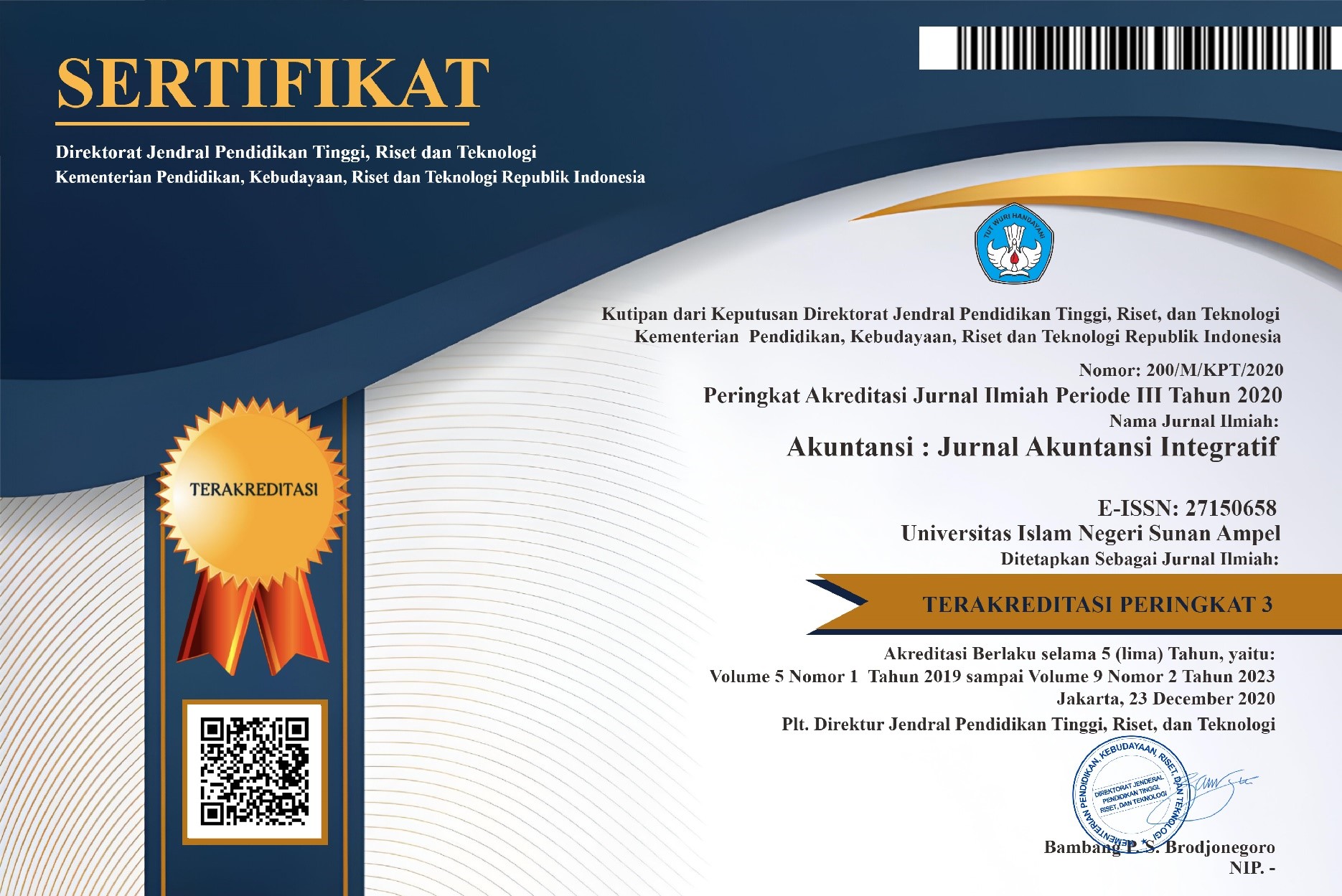Faktor Penentu Pemahaman Mahasiswa Akuntansi Era Covid19 (Studi Empiris Mahasiswa Akuntansi di Jawa Timur)
DOI:
https://doi.org/10.29080/jai.v6i2.314Abstract
This study aims to provide empirical evidence regarding the factors that affect student’s understanding in accounting during Covid 19 pandemic in East Java. There are there variables tested which are learning from home that represent the attitude and behavior of accounting students, the avalilability of IT and students understanding regarding the accounting knowledge. This study is a quantitative method to empirically tested those factors. Sampling method was carried out using a proportional random sampling technique and data was collected using a survey method through an online questionnaire. The results showed that the learning from home variable and the availability of IT had a significant positive effect on students' accounting understanding.
Downloads
References
Amasha, M. A., & AbdElrazek, E. E. (2016). An M-Learning framework in the podcast form (MPF) using context-aware technology. International Journal Of Advanced Computer Science And Applications, 226-234.
Arikunto, S. (2010). Prosedur Penelitian Suatu Pendekatan Praktik. 2010. Jakarta: Rineka Cipta.
Astuti, P. U. J. I., & Hartono, Y. U. S. U. F. (2016, September). Developing ICT-based teaching materials of English for Mathematics course. In Sriwijaya University Learning and Education International Conference (Vol. 2, No. 1, pp. 863-878).
Astuti, P., & Febrian, F. (2019). Blended Learning Syarah: Bagaimana Penerapan dan Persepsi Mahasiswa. Jurnal Gantang, 4(2), 111-119.
Cidral, W. A., Oliveira, T., Di Felice, M., & Aparicio, M. (2018). E-learning success determinants: Brazilian empirical study. Computers & Education, 122, 273-290.
Cheng, Y. M. (2011). Antecedents and consequences of e?learning acceptance. Information Systems Journal, 21(3), 269-299. https://doi.org/10.1111/j.1365-2575.2010.00356.x
DeLone, W. H., & McLean, E. R. (1992). Information systems success: The quest for the dependent variable. Information systems research, 3(1), 60-95.
Gel, Y. R., O’Hara Hines, R. J., Chen, H., Noguchi, K., & Schoner, V. (2014). Developing and assessing e-learning techniques for teaching forecasting. Journal of Education for Business, 89(5), 215-221. https://doi.org/10.1080/08832323.2013.856281
Halawi, L. A., McCarthy, R. V., & Pires, S. (2009). An evaluation of e-learning on the basis of Bloom's taxonomy: An exploratory study. Journal of Education for Business, 84(6), 374-380. https://doi.org/10.3200/JOEB.84.6.374-380
Hanum, N. S. (2013). Keefetifan e-learning sebagai media pembelajaran (studi evaluasi model pembelajaran e-learning SMK Telkom Sandhy Putra Purwokerto). Jurnal Pendidikan Vokasi, 3(1).
Hartanto, W. (2016). Penggunaan E-Learning Sebagai Media Pembelajaran. Jurnal Pendidikan Ekonomi: Jurnal Ilmiah Ilmu Pendidikan, Ilmu Ekonomi dan Ilmu Sosial, 10(1).
Henry, P. (2001). E?learning technology, content and services. Education+ Training.
https://news.detik.com/berita/d-4991485/kapan-sebenarnya-corona-pertama-kali-masuk-ri
Liaw, S. S., Huang, H. M., & Chen, G. D. (2007). Surveying instructor and learner attitudes toward e-learning. Computers & Education, 49(4), 1066-1080. https://doi.org/10.1016/j.compedu.2006.01.001
Masrom, M. (2007). Technology acceptance model and e-learning. Technology, 21(24), 81.
Pavel, A. P., Fruth, A., & Neacsu, M. N. (2015). ICT and e-learning–catalysts for innovation and quality in higher education. Procedia economics and finance, 23, 704-711. https://doi.org/10.1016/s2212-5671(15)00409-8
Pemerintah Indonesia (2020), Peraturan Pemerintah Nomor 21 Tahun 2020 tentang Pembatasan Sosial Berskala Besar dalam rangka Percepatan Penanganan Corona Virus Disease 2019 (COVID-19) (PDF), Jakarta: Kementerian Sekretariat Negara Republik Indonesia.
Romi, I. M. (2017). A model for e-Learning systems success: systems, determinants, and performance.
Samarasinghe, S. M., & Tretiakov, A. (2009). A multi-dimensional measure of e-learning systems success. Proceedings ascilite Auckland, 908-910.
Stricker, D., Weibel, D., & Wissmath, B. (2011). Efficient learning using a virtual learning environment in a university class. Computers & Education, 56(2), 495-504. https://doi.org/10.1016/j.compedu.2010.09.012
Sugiyono, M. P. P., & Kuantitatif, P. (2009). Kualitatif, dan R&D, Bandung: Alfabeta. Cet. VII.
Yusup, F. (2018). Uji validitas dan reliabilitas instrumen penelitian kuantitatif. Tarbiyah: Jurnal Ilmiah Kependidikan, 7(1).
Downloads
Published
How to Cite
Issue
Section
License
Copyright (c) 2020 Ajeng Tita Nawangsari

This work is licensed under a Creative Commons Attribution-ShareAlike 4.0 International License.









